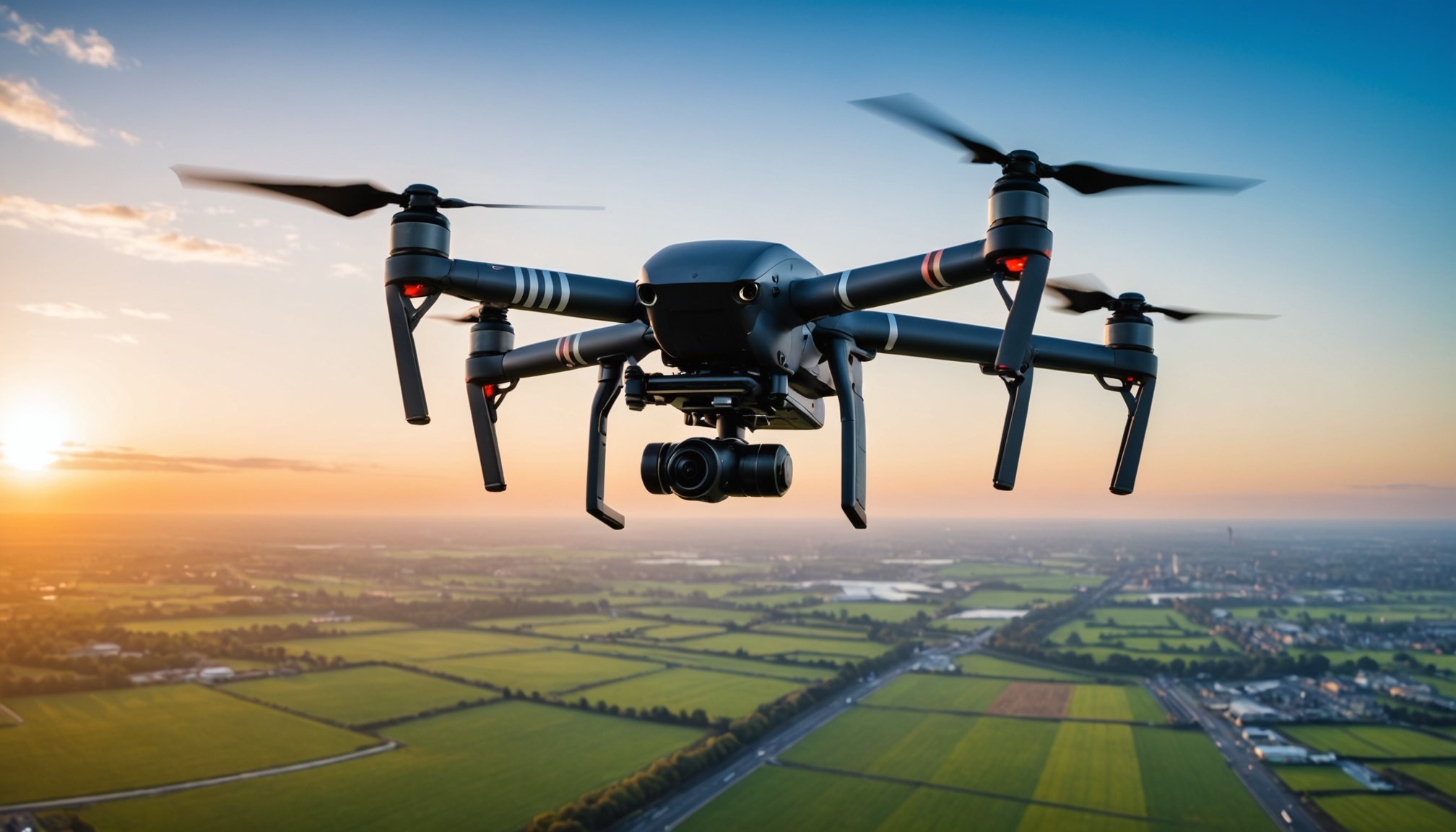Launching Your UK Drone Maintenance Venture: The Ultimate Handbook for Navigating Aviation Safety Compliance
Understanding the Regulatory Landscape
When venturing into the drone maintenance market in the United Kingdom, it is crucial to understand the regulatory framework that governs the use of drones, particularly for critical infrastructure surveillance. The UK’s Civil Aviation Authority (CAA) has recently made significant changes to its drone operation policies, which are set to revolutionize the energy sector.
CAA’s New Drone Policy
The CAA has authorized the use of drones for surveilling critical energy infrastructure, such as power lines and wind turbines. This decision marks a significant shift, enabling more efficient, cost-effective, and safer operations. For instance, drones can now be used to inspect offshore wind farms and other remote assets without the need for physical presence, reducing the risk of interference with commercial aviation and enhancing real-time monitoring capabilities[1].
Also to see : Unlocking financial success: key strategies for tech startups in the uk – an in-depth guide
Obtaining Necessary Permissions and Licenses
Before you can start your drone maintenance venture, you need to ensure you have the necessary permissions and licenses.
Permissions for BVLOS Operations
To operate drones Beyond Visual Line of Sight (BVLOS), you must obtain specific permissions from the CAA. This is particularly important for inspecting large or remote areas, such as offshore wind farms. BVLOS operations require rigorous safety protocols and the use of advanced technology to ensure continuous monitoring and control of the drone[1].
This might interest you : Discover the best website for tailored english classes
Licensing and Certification
Your company and pilots must be certified and licensed by the CAA. This involves completing a series of training programs and passing exams to demonstrate competency in drone operation, safety procedures, and regulatory compliance. Here are some key steps to consider:
- Register Your Drone: If your drone weighs more than 250 grams, you must register it with the CAA.
- Obtain an Operator ID: This is a unique identifier for your company.
- Complete Training and Certification: Ensure all pilots undergo the required training and obtain the necessary certifications.
- Develop an Operations Manual: This manual outlines your company’s safety procedures, emergency protocols, and operational guidelines.
Investing in High Technology
To succeed in the drone maintenance market, you need to invest in high technology that supports efficient and safe operations.
Advanced Drone Capabilities
Modern drones equipped with high-resolution cameras, sensors, and AI can perform detailed inspections quickly and accurately. Here are some key technologies to consider:
- High-Resolution Cameras: For detailed visual inspections.
- Thermal Imaging: To detect temperature anomalies in equipment.
- Lidar Technology: For precise 3D mapping and structural analysis.
- AI and Machine Learning: To automate data analysis and predict maintenance needs.
Data Management and Analysis
Effective data management is crucial for making informed decisions. Here’s how you can leverage data:
- Real-Time Data Transmission: Enable real-time data transmission to your control center for immediate analysis.
- Data Analytics Software: Use specialized software to analyze the data collected, identifying potential issues before they become major problems.
- Integration with Existing Systems: Ensure your data management system integrates seamlessly with existing infrastructure management systems.
Building a Strong Business Model
A successful drone maintenance venture requires a solid business model that addresses market needs, competition, and financial viability.
Market Analysis
Understand the market demand and competition. The UK’s energy sector, particularly the renewable energy segment, is growing rapidly. Here are some key points to consider:
- Market Size and Growth: The UK’s renewable energy sector is expanding, driven by government policies and increasing demand for sustainable energy.
- Competitive Landscape: Identify existing players and their strengths and weaknesses.
- Customer Needs: Understand the specific needs of your potential clients, such as energy companies and infrastructure operators.
Financial Planning
Secure the necessary funding and plan your finances carefully. Here are some considerations:
- Initial Investment: Calculate the initial investment required for drones, technology, training, and licensing.
- Revenue Streams: Identify potential revenue streams, such as subscription-based services, one-off inspections, and maintenance contracts.
- Venture Capital and Funding: Explore options for venture capital, government grants, and private sector investments.
| Financial Aspect | Description |
|---|---|
| Initial Investment | Drones, technology, training, licensing |
| Revenue Streams | Subscription-based services, one-off inspections, maintenance contracts |
| Venture Capital | Explore venture capital firms, government grants, private sector investments |
| Operational Costs | Fuel, maintenance, personnel costs |
| Potential Returns | Increased efficiency, reduced costs, enhanced safety |
Ensuring Aviation Safety Compliance
Compliance with aviation safety regulations is paramount to avoid legal and operational risks.
Air Traffic and Air Navigation
Ensure your drone operations do not interfere with air traffic and air navigation systems. Here are some guidelines:
- Air Traffic Control: Coordinate with air traffic control to ensure your drone operations do not conflict with manned aircraft.
- Air Navigation Systems: Use approved navigation systems to avoid collisions and ensure safe separation from other air traffic.
Research and Development
Stay updated with the latest research and development in drone technology and safety protocols. Here are some ways to do this:
- Industry Conferences: Attend industry conferences and workshops to stay informed about new technologies and regulatory updates.
- Collaborations: Collaborate with research institutions and other companies to share knowledge and best practices.
- Government Initiatives: Participate in government initiatives and programs aimed at advancing drone technology and safety.
Leveraging Government Support and Private Sector Investment
Both government support and private sector investment can be crucial for the success of your drone maintenance venture.
Government Initiatives
The UK government offers various initiatives to support innovation and entrepreneurship in the drone sector. Here are some examples:
- Grants and Subsidies: Apply for grants and subsidies aimed at promoting innovation in the energy and aviation sectors.
- Regulatory Support: Engage with regulatory bodies to ensure your operations comply with the latest regulations and to influence policy changes that benefit your business.
- Public-Private Partnerships: Collaborate with government agencies and other private sector companies to leverage resources and expertise.
Private Sector Investment
Private sector investment can provide the necessary capital to scale your business. Here are some considerations:
- Venture Capital Firms: Approach venture capital firms that specialize in technology and innovation.
- Business Banks: Engage with business banks that offer specialized loans and financial services for startups.
- Private Markets: Explore private markets and angel investors who are interested in high-growth potential businesses.
Case Studies and Success Stories
Looking at case studies and success stories can provide valuable insights and practical advice.
Mirion Technologies
Mirion Technologies, for example, was awarded strategic contracts for the Sizewell C new nuclear power station project in the UK. This highlights the potential for drone technology in critical infrastructure inspection and maintenance[3].
Hemeria Group
The Hemeria Group, a leader in stratospheric balloons and drone technology, has successfully launched several projects, including the BalMan stratospheric balloon and collaborations with Astroscale Ltd for space debris removal. These examples demonstrate the innovative use of drone and related technologies in various sectors[4].
Practical Advice and Next Steps
Here are some practical tips and next steps to consider when launching your drone maintenance venture:
Develop a Comprehensive Business Plan
- Outline your market strategy, financial projections, and operational plan.
- Identify key stakeholders and partners.
Build a Strong Team
- Hire experienced pilots and engineers.
- Invest in ongoing training and certification.
Engage with Regulatory Bodies
- Regularly update your knowledge of regulatory changes.
- Participate in industry forums and workshops.
Leverage Technology
- Invest in the latest drone technologies and data analytics tools.
- Integrate your systems with existing infrastructure management systems.
Launching a drone maintenance venture in the UK requires a deep understanding of the regulatory landscape, investment in high technology, and a solid business model. By leveraging government support, private sector investment, and staying updated with the latest research and development, you can navigate the complexities of aviation safety compliance and establish a successful business.
As Nicholas Cumins, CEO of Bentley Systems, emphasizes, “The future of infrastructure engineering is open, flexible, and collaborative, relying on data that can be shared securely.” This vision is particularly relevant in the drone maintenance sector, where open data ecosystems and advanced technologies are transforming the way we manage and maintain critical infrastructure[5].
By following this handbook, you can ensure your new venture is well-positioned to capitalize on the growing demand for drone-based services in the UK, contributing to a safer, more efficient, and innovative aviation and energy sector.











